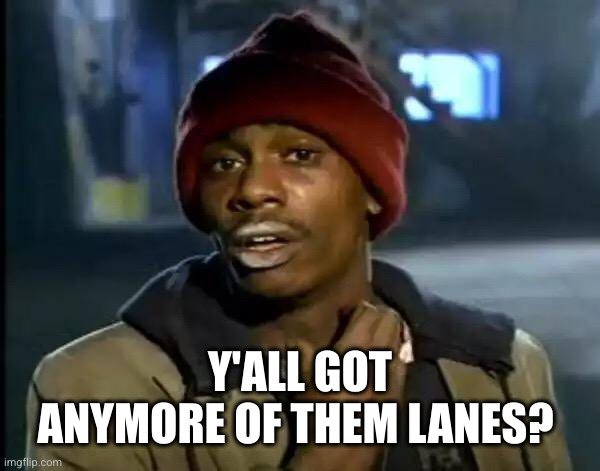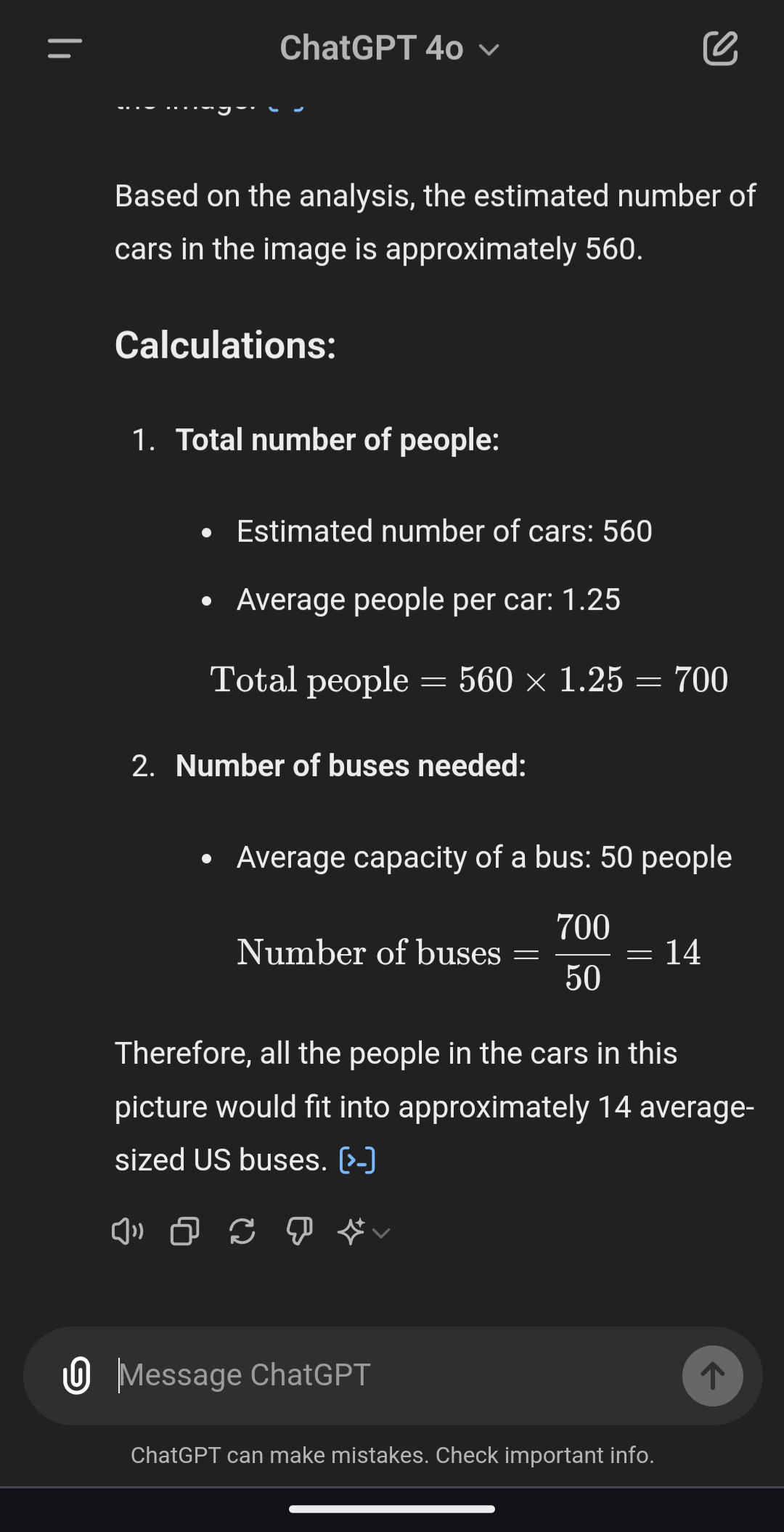Sorry- “progress”???
I was being ironic.
Totally missed that tone. My bad, sorry.
le sigh though
Text isn’t always the best medium to convey irony/sarcasm.
Anything but a fucking train…
Coincidentally they form train-like structure, without all the benefits.
Soooo like for profit health insurance? Murica
And quintuple the emissions
Yup. Trains are stupidly efficient.
I know. They should add more lanes.
/s
I hate cars and highways so much.
I wish we had good mass transit like Europe.
Everyone always disparages the cost of public transport but how much does it cost to maintain these highways every year? A few dozen/hundred billion dollars across the country?
In USA they fund maintenance by developing the sprawl. So they are stuck in this circle where if they don’t develop, they can’t maintain, but developing means more surface to maintain, etc.
Also how much supposed leasure time is wasted sitting in all those cars, making the people frustrated, sick and unfulfilled?
they’re not really maintained much anymore other than minor stuff. even that costs tons of money and is of minimal benefit for job security of departments doing it. you’ll all be dead before any major development or changes occur. and even if they decided to do something major, the construction of it while you wait for it to be done over the years will make transportation even more unbearable for those years.
China’s mass transit is better. Probably we should just hire the Chinese to construct a national bullet train network in ten years like they did in China. But wait, we can’t do that because that threatens the profits of the bourgeoisie, who are the true rulers of amerikkka. Oh well, enjoy your eight hour commute to make your bosses richer!
Japan pretty much has it figured out. Bunch of trains, slow or fast, fancy or frugal. Whatever fits you there’s an option. You can get a Pikachu train with a shop and children’s playground if you want to.
Tofu dregs. You should look that up.
China also kinda just forces anyone out who’s in the way. To build any new infrastructure the US ends up getting slowed down to a crawl because of red tape and beurocracy. Land owners have a lot more rights in the US.
Unless the landowners are Black or Indigenous. I don’t recall euro-kkkolonizers asking their opinion about colonization either in the seventeenth century or today.
I’m not talking about history. I’m talking about the US today.
I’m not taking sides really, but I just want to point out that the US very much DOES still do shit to bipoc communities regarding infrastructure and construction and housing.
They will run a new highway right through a neighborhood. And sure, they offer to buy up the land first usually, so that’s nice I guess, but they don’t pay well for it and if you don’t move they just take it anyway. Rail lines run through lower income areas. Highways too. There are “easements” and “imminent domain” legal fuckery that they use against bipoc people mostly too. If it’s a rich neighborhood they go around, if it’s poor people tough luck to them.
Residential can also get rezoned to commercial and force everyone out.
There are LOTS of legal and quasi legal things that are done all the time here. But even the legal ones are often ethically/morally wrong.
So there’s that.
How can you separate one from the other? History doesn’t just begin and end at the convenience of white supremacists. When did the colonization end, for instance? All the euro-kkkolonizers are still here, they just changed their flag and started sending their taxes to DC instead of London.
These “euro-kkkolonizers” were all several generations ago. Maybe you want to pretend nothing has changed, but things have gotten significantly better since then.
I won’t pretend we don’t still have problems. People of color are still statistically lower income, and they’re still affected by all the same capitalist problems that come with that.
The problem is also not the same across the country. Every state has their own top issues.
Which corporate CIA source should I use to excuse the nazis who run the USA?
One more lane, bro

Just one more and it’ll all be fixed, trust me bro
I swear bro, just one more, please
Worked every time so far, I swear!
WE’RE GONNA FIX TRAFFIC, FOR REAL THIS TIME
Double it and pass the problem to the next generation
There are 2-4 HOV/toll lanes in the middle depending on where you are in the city. I only see 2 in this photo, and they aren’t called out in OP’s title.
shit could have been 1 long passenger and 1/10th of a freight train
And was we can all observe, it has solved traffic for Houston due to accommodating all the cars possible by upgrading with enough lanes perpetually.
It is expected to be complete once the lanes exceed N+1 or the population drops below N.
Everybody in this photo could fit in like 4 buses
See, this is what AI was actually made for. 14 buses.

Always remember LLMs are trained to sound correct to the human mind, not be correct.
Well done
For a small segment of the trip. The problem with public transportation is that all these people are going to different locations and a bus being more efficient for 50% of the travel doesn’t really help you for the other 50%
The problem is not with public transportation, the problem is that the area surrounding this highway was designed so that more cars and more lanes were the only possible solution.
Cars create problems that only cars can solve.
Edit: and to add more context: those 50 different locations are all separated by massive mandatory parking lots which make them miles apart from each other when they could likely all be contained in the same building in front of a single bus stop.
As someone who has lived alone for eight years using only public transport in an area with excellent public transport, I can tell you that you are both right and wrong.
You are right in that if there is just one bus line, then it would only serve a small subset of people in this photo.
But if you only make one bus line then the public transport system is doomed to fail.
A good public transport system will have multiple lines converging to the same interchange, and in the opposite direction it will have multiple lines departing the same interchange, following the same route and branching off when needed, this way you have added capacity and redundancy at the start of the line, and it gets reduced as the need is reduced.
Then add lines that are circles in higher density areas, this means that no matter the direction all passengers can get on all departures, you csn also quickly add capacity by adding busses that goes in alternating directions.
All of this means that travellers can define their own route along different bus, train, tram, metro and ferry lines.
Public transport is not ment to be point to point, it builds a framework where people decide what parts the want to use.
95% of Londoners are 400m or less from a bus stop. The bus service suits everyone for any journey. And then we have trains and the tube. There’s never a need for a car no matter where and when you go.
London wasn’t developed after the automobile. Houston’s metroplex covers a much larger area with a much smaller population, which makes London’s solutions much less practical.
The closest bus stop to someone in Alvin or Bellville may be 20 miles away, and they’ll have to change busses 7 times to get where they’re going.
And to put numbers to your points, London’s population density is 14,600 people per square mile, while urban Houston is only 3,340.
And if you want to talk about the broader metropolitan area, then London goes down to 3,900 people/sq. mi., which is close to Houston’s urban area. However, if we look at Houston’s equivalent to that the density drops to 862/sq mi.
Also, London’s metro is 3,236 square miles. Houston’s is 10,062.
Anyone who compares these as equivalent is disingenuous or ignorant (not necessarily maliciously so, but likely just unaware or oblivious to the massive sprawl that Texas cities have).
That’s cool that Londoners all live so close to each other and have a city built around public transportation. Unfortunately as someone who lives in Texas a car really us practically mandatory. Our Urban sprawl is large and it’s not something that can or will be easily fixed even over multiple lifetimes. To give an idea of what it is like over here, the nearest grocery store is a little over 3 miles (~5 km) away from where I live. There is no bus route within a 2 mile (~3km) area of me that provides transportation to that area.
The public transportation we do have is lacking in availability, accessibility, and coverage. and while there are ongoing efforts to update it. These updates primarily apply to the inner parts of the large cities and rarely cover the urban living areas where people actually live at. And these living areas are frequently very far away from where public transportation is available.
The main problem is that Texas cities are just too expansive in size for public transportation to currently be effective. This isn’t even factoring in how long commutes would take to be for some people even if they where somehow magically available tomorrow.
For example, many of my co-workers on my overnight shift live far enough away that commuting to work in a car during the dead of night on an empty highway road where they drive 75+ mph ( 120+kph) still takes them an hour or more to arrive to work daily. This is consider a common and even somewhat normal commute time and distance in Texas. If they had to take public transportation they would be looking at an over 2+ hour commute everyday at best. So that is not really a viable option for them.
Im really happy that Europeans have more dense cities and don’t have to deal with the same problems we have. But it honestly gets tiring hearing everyone say public transportation be the solution for everything in Texas. Yes it would very much help and efforts are being made. But due to how Texas cities where laid out and planned with urban sprawl in mind multiple decades ago before even my grandfather was able to give input. We can no longer have public transportation be a viable option for a large segment of the people who live here.
What Texas needs is both public transport AND better highway road planning, for example more exits and on ramps, more alternative routes to free up congestion on major feeder arteries. Not more lanes on the same congested routes, off ramps, feeders, etc.
Sorry for the rant, I just fucking hate the traffic here and it’s causes have become my mini soapbox of annoyance
Well, I understand that. But the change should start somewhere and somehow, right? I can only provide you with examples how the public transport works elsewhere, but you’ll have to do some ground work yourself, like advocating for public transport, voting for more responsible government, etc. Or… Make America Great Britain Again!
Unless there’s another bus for the other 50% of the travel. The point of a public transportation system is to be just that - a system. To get from anywhere to anywhere else.
Where I live this will cause what would be a 15 minute car ride into 1.5 hours of hopping on different busses and then walking 1/2 mile to your destination on either end. I don’t have a problem with effective public transportation but outside of major population centers like Manhattan, I haven’t seen one that really works all that well here in the US.
Well, that’s the thing you could have it if you invested all the money that currently goes into highways. The amount of money is always limited (everybody hates taxes for a reason), so building large quantities of both is impossible.
Roads are always going to cost more in the end, but they’re easier to build incrementally. Boiling the frog situation.
Even if policy of your local government changes (which is at least a little up to you) you will still have to suffer the current situation and keep driving for a while before a better system is built. But that’s no reason to throw good money after the bad.
It wouldn’t be a 15 minutes car ride once the traffic jams start. The point of public transport is not to completely replace cars, but to provide an alternative for people. A good public transport system will cover most destinations so people won’t have to worry like you do about reaching your destination. By doing so, it will reduce cars on the road which will also benefit the people who do need to drive to where they want to go.
Oh sorry, 20 buses to cover all the sectors these people are going to then.
So what?
Living in a city with actually good public transit, it is used to achieve exactly that. To get any one passenger from any one point within the metropolitan area, to any other. To work for everyone, even though every single person is starting from a different point, and going to a different destination.
It doesn’t matter where you’re going or from where. There is a public transit stop nearby at both ends.
The fuck do you mean “a small segment of the trip”? I share this city with a stupid number of other humans, only a small number of which I go to work with every day, yet a significant portion of of the entire city population travels to work, entertainment and shopping, using the exact same transit network.
Your trip may overlap with a varying number of entirely different individuals along each segment of the route, and at each end it might just be you walking a few dozen meters… But come on! The fact that it adds up is beyond obvious!
Your argument is only valid for mass transit, that isn’t actually mass transit.
And as density goes up (read less roads and carparks), the overlaps INCREASE and the whole thing gets more efficient.
There is a train station in Tokyo, that serves the same number of people every day, as there are citizens in my entire country.
Can you even imagine what a highway interchange that could serve 5 million people within 24 hours would look like? No, because it’s a physical impossibility.
The only reason the number can get so high, is because transit systems consolidate travellers even when they aren’t going to the same places.
You know, buses… They make more than one stop.
That’s why frequency is one of the most important factors for public transportation.
And good coverage.
They’re all up there. I’d probably go with
Safety Frequency Availability (operating hours) Coverage Cost
All of that, for a traffic jam. Imagine turning 4 lanes in a train track carrying 500 person every 5 min in both directions and one lane in a bike lane. It’s still 20 lanes for car, but you suddenly have decent public transport which would be safer and faster than that gigantic traffic jam
One train! A single train track solves all of this. No need for two. Just one. In the picture you don’t see more than 500 or so people and that fits in no more than 5 modern train cars, with toilets, refreshments and other amenities. And it moves faster.
Or just a decent bus system. You could replace 50 cars on that highway with a single bus.
It’s always first and last leg in Texas that kills this stuff.
The only affordable housing is far enough outside the city that you basically have to own a car because there’s not enough density to have bus stops.
And going to a park park and ride following by waiting on the bus adds another 30-40 minutes to the commute and gets your car broken into 3 times a year, so nobody uses them.
The real solution is to mandate allowing remote work for positions where it is a viable option.
I commute 4 hours a day for a job where I log into a computer and do all my work online. If people like me were allowed to work remote we’d have more time with our families, traffic would be reduced, and housing closer the city would get cheaper for those who DO need to work in-person.
Yeah, well, many people are deeply stupid. And selfish. And racist. But I repeat myself.
Personally I think anyone who goes like “I don’t want to ride a train I might have to sit next to a black person” should be dealt with more assertively, but I’m not in charge.
From the picture, I count 16 lanes. Is the pic accurate?
Am I the only one not seeing 26 landed here?
I think this is a picture before the most recent expansion. (They saw this picture and said “hmm not wide enough, too congested.”)
In the normal parts:
- 2 express/toll/HOV/carpool lanes
- 5 regular highway lanes
- 3 feeder lanes (in Texas, the highways tend to have “feeders” or “service roads” or “frontage roads” that run parallel to highways so that people can exit and enter, turn onto intersecting roads, and access local businesses, and Houston calls them “feeders”).
That’s 10 in each direction. But at any given time there might be merge lanes between the express and the regular lanes, between the highway and the feeder, or between the feeder and a turn lane. So at the widest point, around the major freeway intersection with another huge toll highway, they bump it up to one more of each type of lane, for 13 lanes in each direction.
There’s also a fair debate about whether the feeder lanes should count. After all, they have traffic lights and intersections to deal with. But on the other hand, driving on them is necessary to get on and off the highway lanes, so in a sense it’s part of the same highway.
Yeah that’s a better description.
Also of note this is part of the evacuation system for hurricanes. All lanes are outbown in an evacuation.
But it also kinda hides some of the crappyness. it was supposed to be on top of a giant underground flood diversion system which is a huge problem for Houston as you may have heard. Also the center was supposed to be for a commuter rail but we couldn’t get the bond passed so that might happen someday…
Unless they count the shoulders as their own lanes, I don’t see 26 either.
Hear me out: stack it vertically. It’ll be great, I promise
Yeah, we attempted a surprise vertical stacking on the highway one time. 0/10 would not try again
Got to practice my first aid skills, though, and I even picked up a few stories for my first aid classes.
THAT’S MY AMERICA 🇺🇸 🦅🔥🔥🔥 ONE MORE LANE DOESN’T FIX IT MY A$$ LOOK AT THIS AND TELL ME IT ISN’T WORKING 🇺🇸🇺🇸🦅🔥🔥🔥🦅🦅
Counting the service road is kind of cheating. In built up areas in Texas they’re de facto city streets that happen to exactly mirror the freeway. They have intersections, lights, businesses, etc.
Yep. Texas does that because of a state law that says any landowner with property adjacent to a highway has a right to access that highway.
Fwiw, feeder lanes probably shouldn’t be counted in Texas because they’re basically glorified city streets. Businesses can have entrances and exits on frontage roads, so there’s not really anything special about them except that they have a slightly higher speed limit (50~60mph vs 40~45mph) and they have immediate access to the highway.
The feeder there is also almost certainly 45. So not really any faster than normal stroads.
I was going to ask if they count the frontage roads as part of the highway in TX. Because that’s not right.










